
| Version | Summary | Created by | Modification | Content Size | Created at | Operation |
|---|---|---|---|---|---|---|
| 1 | Attilio Converti | + 2572 word(s) | 2572 | 2021-08-26 12:16:52 | | | |
| 2 | Lindsay Dong | Meta information modification | 2572 | 2021-09-28 08:20:14 | | |
Video Upload Options
Bacterial cellulose membranes have been shown to be efficient as filters for the removal of various contaminants, including biological and chemical agents or heavy metals. Therefore, their use could make an important contribution to bio-based technological development in the circular economy. Moreover, they can be used to produce new materials for industry, taking into consideration current environmental preservation policies aimed at a more efficient use of energy.
1. Introduction
Water resources are essential for industrial activities, energy production, agriculture, and life on earth [1]. In particular, the access to potable water and efficient treatment methods are essential for the prevention of various types of pollution and waterborne diseases [2]. It is possible to reduce the load of pollutants through the interconnection of different industrial sectors, so that their by-products are treated and reused, and waste production is minimized, with the perspective of becoming raw material in a new production cycle [3].
Industrial pollutants such as dyes, synthetic chemicals, heavy metals, oils, microplastics and others can have different origins and properties, and many of them accumulate in the environment over time, causing increasing damage [4]. According to Rajasulochana and Preethy [5], the methods of industrial wastewater treatment vary according to several factors, including volume, constitution of the effluent and limits imposed by environmental legislations. Increased research on renewable energy and energy saving technologies has favored the development of new processes and materials as alternatives to treat complex wastewater [6][7].
2. Water Resources and Energy Management
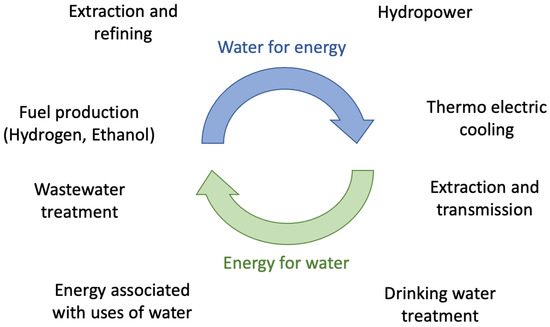
3. Water Contamination
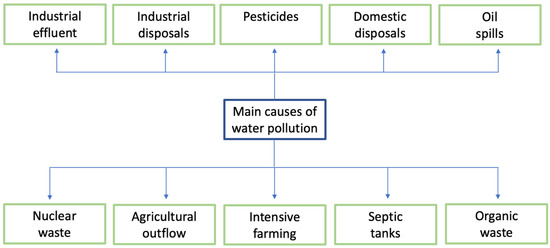
4. Filtration Membranes
| Classification | Application | Pore Size (nm) | Reference |
|---|---|---|---|
| Microfiltration (MF) | Removal of suspended solids, protozoa, and bacteria | 100–5000 | [32] |
| Ultrafiltration (UF) | Removal of viruses and colloids | 2–100 | [33] |
| Nanofiltration (NF) | Removal of water hardness, heavy metals, and dissolved organic matter | 0.5–2 | [33] |
| Reverse osmosis | Desalination, water reuse and ultra-pure water production | 0.2–1 | [34] |
5. Bacterial Cellulose Membranes
Cellulose, composed of glucose monomers, is the main structural biopolymer of plants, but it can be also produced by other life forms such as bacteria, fungi and even protozoa. Such a natural bioproduct, whose great technological importance is justified by its wide variety of applications [35], is the most abundant in the world, with an estimated annual production of 1011 tons, most of which is of vegetable origin [36].
According to Donini et al. [35], bacterial cellulose (BC) differs from vegetable cellulose (VC) in that it has nanometric rather than micrometric size, better mechanical properties such as higher tensile strength and flexibility, higher purity given that VC is naturally linked to hemicellulose and pectin, higher crystallinity, water retention capacity, biocompatibility, biodegradability and biological adaptability [37][38]. These peculiar properties (Figure 3), attributable to the inter and intramolecular hydrogen bonds that hold the polymer chains together [28], make BC an extremely versatile biopolymer that can be used in various sectors of economic importance.
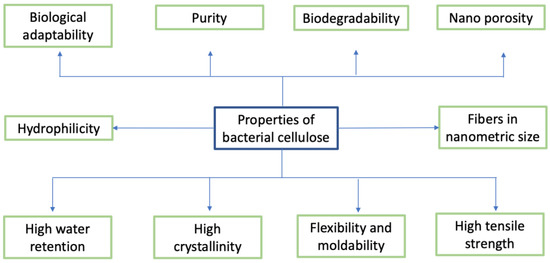
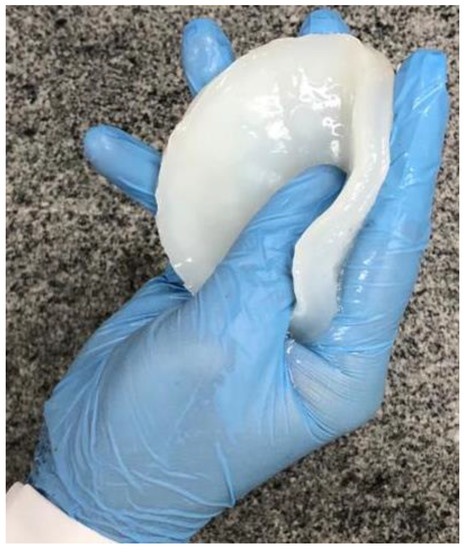
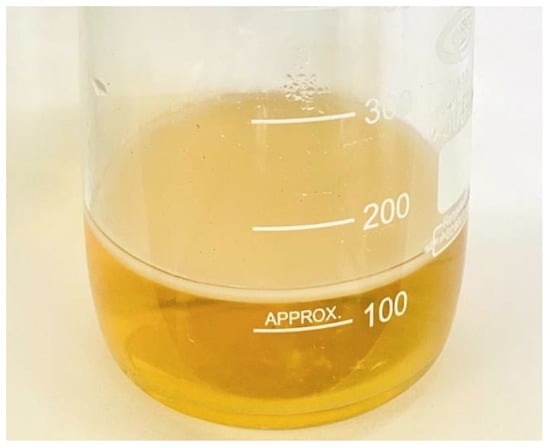
6. Bacterial Cellulose in Wastewater Treatment

| Title | Description | Reference |
|---|---|---|
| Surface modification of bacterial cellulose aerogels’ web-like skeleton for oil/water separation | Nanofibers of BC aerogels were modified on their surfaces by trimethylsilylation derivatization followed by freeze-drying. The resulting hydrophobic and oleophilic aerogels were shown to remove a wide range of organic solvents and oils, with potential use in cleaning up oil spills in the marine environment. | [16] |
| Polyethyleneimine-bacterial cellulose bioadsorbent for effective removal of copper and lead ions from aqueous solution | Reductive amination with polyethyleneimine allowed to transform the BC membrane into a bioadsorbent for the removal of heavy metal ions [Cu (II) and Pb (II)] from wastewater. | [46] |
| Facile fabrication of flexible bacterial cellulose/silica composite aerogel for oil/water separation | A silica aerogel composite was prepared by BC modification with methylene diphenyl diisocyanate to increase its hydrophobicity and flexibility, thus making it a promising oil sorbent. | [48] |
| Preparation and characterization of a bi-layered nanofiltration membrane from a chitosan hydrogel and bacterial cellulose nanofiber for dye removal | A membrane was developed by grafting multi-walled carbon nanotubes into BC molecular chains. The BC powder was dissolved in a solution of LiCl and N,N-dimethylacetamide, and stannous octoate was used as a reaction catalyst. The membrane exhibited greater tensile strength, Young’s modulus and pressure resistance, which practically tripled its flow rate and allowed for a yield of dye removal above 90%. | [51] |
| Design of reusable novel membranes based on bacterial cellulose and chitosan for the filtration of copper in wastewaters | Chitosan-modified BC membranes were developed by ex situ (BC immersed in solutions with different chitosan concentrations) or in situ (addition of chitosan solutions to BC production medium) techniques for Cu (II) ions adsorption. The membrane produced by the ex situ technique showed greater efficiency in removing ions. | [52] |
| Removal of U(VI) from aqueous solution using phosphate functionalized bacterial cellulose as efficient adsorbent | BC membranes were modified by grafting phosphate functional groups soaking them in dimethylacetamide and urea. Membrane characterization confirmed the successful incorporation of phosphate groups. Due to the presence of polar hydroxyl groups and electrostatic attraction, the membranes at pH between 4 and 8 were able to adsorb 9 mg/g of U (IV) ions. | [53] |
| Bacterial cellulose membranes for environmental water remediation and industrial wastewater treatment | BC was produced and cleaned with NaOH to be used as a filter membrane for the treatment of microbiologically contaminated effluents (Escherichia coli) and dyes from the textile industry. BC membranes showed better results than the commercial ones, removing 100% of cells present in the effluent and being able to be reused for 10 cycles without loss of efficiency. | [54] |
| Impact of incubation conditions and post-treatment on the properties of bacterial cellulose membranes for pressure-driven filtration | Studies on the permeation properties of BC derivatized with poly-oxyethylene were carried out to determine the filtration efficiency of both dry and wet membranes at different pressures and water flow rates. | [28] |
| Film-like bacterial cellulose/cyclodextrin oligomer composites with controllable structure for the removal of various persistent organic pollutants from water | A film-like water purifier, prepared by loading cyclodextrin oligomer onto ultrafine BC, was described. The system showed high and stable adsorption capacity toward various target pollutants such as phenol, bisphenol A, glyphosate and 2,4-dichlorophenol. | [55] |
| Bacterial cellulose-polyaniline porous mat for removal of methyl orange and bacterial pathogens from potable water | BC membranes were modified with polyaniline by in situ oxidative polymerization and posterior lyophilization. BC was applied to remove methyl orange dye and bacterial cells present in drinking water. Membranes showed an absorption capacity of approximately 300 mg/g and antimicrobial activity, reducing the microbial load present in the effluent by up to four times. | [56] |
7. Conclusions and Perspectives
References
- Del Borghi, A.; Moreschi, L.; Gallo, M. Circular economy approach to reduce water–energy–food nexus. Curr. Opin. Environ. Sci. Health 2020, 13, 23–28.
- Ighalo, J.O.; Adeniyi, A.G.; Adeniran, J.A.; Ogunniyi, S. A systematic literature analysis of the nature and regional distribution of water pollution sources in Nigeria. J. Clean. Prod. 2021, 283, 124566–124602.
- Mikulčić, H.; Baleta, J.; Klemel, J.J. Sustainability through combined development of energy, water and environment systems. J. Clean. Prod. 2020, 251, 119727–119762.
- Chaudhry, F.N.; Malik, M.F. Factors affecting water pollution: A review. J. Ecosyst. Ecography 2017, 7, 1000225–1000228.
- Rajasulochana, P.; Preethy, V. Comparison on efficiency of various techniques in treatment of waste and sewage water–A comprehensive review. Resour. Eff. Technol. 2016, 2, 175–184.
- Galdino, C.J.S.; Maia, A.D.M.; Meira, H.M.; Souza, T.C.; Amorim, J.D.P.; Almeida, F.C.G.; Costa, A.F.S.; Sarubbo, L.A. Use of a bacterial cellulose filter for the removal of oil from wastewater. Process Biochem. 2020, 91, 288–296.
- El-Gawad, H.S.A. Oil and grease removal from industrial wastewater using new utility approach. Adv. Environ. Chem. 2014, 2014, 916878.
- Lee, K.P.; Arnot, T.C.; Mattia, D. A review of reverse osmosis membrane materials for desalination—Development to date and future potential. J. Membr. Sci. 2011, 370, 1–22.
- Wang, J.; Lautz, L.S.; Nolte, T.M.; Posthuma, L.; Koopman, K.R.; Leuven, R.S.W.; Hendriks, A.J. Towards a systematic method for assessing the impact of chemical pollution on ecosystem services of water systems. J. Environ. Manag. 2021, 281, 111873–111882.
- Cannon, R.; Anderson, S.M. Biogenesis of bacterial cellulose. Crit. Rev. Microbiol. 1991, 17, 435–447.
- Rachtanapun, P.; Jantrawut, P.; Klunklin, W.; Jantanasakulwong, K.; Phimolsiripol, Y.; Leksawasdi, N.; Seesuriyachan, P.; Chaiyaso, T.; Insomphun, C.; Phongthai, S. Carboxymethyl bacterial cellulose from nata de coco: Effects of NaOH. Polymers 2021, 13, 348.
- Amorim, J.D.P.; Souza, K.C.; Duarte, C.R.; Duarte, I.S.; Ribeiro, F.A.S.; Silva, G.S.; Farias, P.M.A.; Stingl, A.; Costa, A.F.S.; Vinhas, G.M. Plant and bacterial nanocellulose: Production, properties and applications in medicine, food, cosmetics, electronics and engineering. A review. Environ. Chem. Lett. 2020, 18, 851–869.
- Wanichapichart, P.; Kaewnopparat, S.; Buaking, K.; Puthai, W. Characterization of cellulose membranes produced by Acetobacter xyllinum. Songklanakarin J. Sci. Technol. 2002, 24, 855–862.
- Mautner, A.; Lee, K.Y.; Lahtinen, P.; Hakalahti, M.; Tammelin, T.; Li, K.; Bismarck, A. Nanopapers for organic solvent nanofiltration. Chem. Commun. 2014, 50, 5778–5781.
- Carpenter, A.W.; Lannoy, S.-F.; Wiesner, M.R. Cellulose nanomaterials in water treatment technologies. Environ. Sci. Technol. 2015, 49, 5277–5287.
- Sai, H.; Fu, R.; Xing, L.; Xiang, J.; Li, Z.; Li, F.; Zhang, T. Surface modification of bacterial cellulose aerogels’ web-like skeleton for oil/water separation. ACS Appl. Mater. Interfaces 2015, 7, 7373–7738.
- Calvin, K.; Patel, P.; Clarke, L.; Asrar, G.; Bond-Lamberty, B.; Cui, R.Y.; Di Vittorio, A.; Dorheim, K.; Edmonds, J.; Hartin, C.; et al. GCAM v5.1: Representing the linkages between energy, water, land, climate, and economic systems. Geosci. Model. Dev. 2019, 12, 677–698.
- Vaidya, R.A.; Molden, D.J.; Shrestha, A.B.; Wagle, N.; Tortajada, C. The role of hydropower in South Asia’s energy future. Int. J. Water Resour. Dev. 2021, 37, 367–391.
- Xiong, W.; Li, Y.; Pfister, S.; Zhang, W.; Wang, C.; Wang, P. Improving water ecosystem sustainability of urban water system by management strategies optimization. J. Environ. Manag. 2020, 254, 109766–109774.
- Zhai, S.; Li, M.; Peng, H.; Wang, D.; Fu, S. Cost-effective resource utilization for waste biomass: A simple preparation method of photo-thermal biochar cakes (BCs) toward dye wastewater treatment with solar energy. Environ. Res. 2021, 194, 11–720.
- Taghizadeh-Hesary, F.; Taghizadeh-Hesary, F. The impacts of air pollution on health and economy in Southeast Asia. Energies 2020, 13, 1812.
- Malik, D.S.; Sharma, A.K.; Thakur, R.; Sharma, M. A review on impact of water pollution on freshwater fish species and their aquatic environment. In Advances in Environmental Pollution Management: Wastewater Impacts and Treatment Technologies, 1st ed.; Kumar, V., Kamboj, N., Payum, T., Eds.; Agro Environ Media—Agriculture and Ennvironmental Science Academy: Haridwar, India, 2020; pp. 10–28.
- Rocha e Silva, F.C.P.; Rocha e Silva, N.M.P.; Luna, J.M.; Rufino, R.D.; Santos, V.A.; Sarubbo, L.A. Dissolved air flotation combined to biosurfactants: A clean and efficient alternative to treat industrial oily water. Rev. Environ. Sci. Biotechnol. 2018, 17, 591–602.
- Zouboulis, A.I.; Avranas, A. Treatment of oil-in-water emulsions by coagulation and dissolved air flotation. Colloids Surf. A Physicochem. Eng. Asp. 2000, 172, 153–161.
- Demore, J.P. Aspectos Sedimentares do Estuário da Lagoa dos Patos e Sua Interação Com a Poluição por Petróleo: Subsídios Para um Plano de Contingência. Bachelor’s Thesis, Fundação Universidade Federal do Rio Grande, Rio Grande, RS, Brazil, 2001.
- Luo, F.; He, L.; He, N. Simulation and experimental study of working characteristics of an improved bioreactor for degrading oily sludge. Process Saf. Environ. Prot. 2021, 147, 1201–1208.
- Silva, W.E.; Belian, M.F.; Lima, L.S.G.L.; Galembeck, A.; Alves, A.A. BR 10 2018 009736 9 A2–Filtros à Base de Membrana de Celulose Bacteriana Modificada; INPI: Rio de Janeiro, Brazil, 2018.
- Lehtonen, J.; Chen, X.; Beaumont, M.; Hassinen, J.; Orelma, H.; Dumée, L.F.; Tardy, B.L.; Rojas, O.J. Impact of incubation conditions and post-treatment on the properties of bacterial cellulose membranes for pressure-driven filtration. Carbohydr. Polym. 2021, 251, 117073–117082.
- Mo, X.; Ni, Y.; Liu, F. Preparation of different scale firous membranes and their filtration properties. Therm. Sci. 2021, 25, 1453–1459.
- Gao, H.; He, W.; Zhao, Y.-B.; Opris, D.M.; Xu, G.; Wang, J. Electret mechanisms and kinetics of electrospun nanofiber membranes and lifetime in filtration applications in comparison with corona-charged membranes. J. Membr. Sci. 2020, 600, 117879.
- Padaki, M.; Surya Murali, R.; Abdullah, M.S.; Misdan, N.; Moslehyani, A.; Kassim, M.A.; Hilal, N.; Ismail, A.F. Membrane technology enhancement in oil–water separation. A review. Desalination 2015, 357, 197–207.
- Anis, S.F.; Hashaikeh, R.; Hilal, N. Microfiltration membrane processes: A review of research trends over the past decade. J. Water Process Eng. 2019, 32, 100941.
- Cassano, A.; Conidi, C.; Ruby-Figueroa, R.; Castro-Muñoz, R. Nanofiltration and tight ultrafiltration membranes for the recovery of polyphenols from agro-food by-products. Int. J. Mol. Sci. 2018, 19, 351.
- Qasim, M.; Badrelzaman, M.; Darwish, N.N.; Darwish, N.A.; Hilal, N. Reverse osmosis desalination: A state-of-the-art review. Desalination 2019, 459, 59–104.
- Donini, Í.A.N.; Salvi, D.T.B.; Fukumoto, F.K.; Lustri, W.R.; Barud, H.S.; Marchetto, R.; Messaddeq, Y.; Ribeiro, S.J.L. Biossíntese e recentes avanços na produção de celulose bacteriana. Eclet. Quim. J. 2010, 35, 165–178.
- Jardine, A.; Sayed, S. Challenges in the valorization of chitinous biomass within the refinery concept. Sustain. Chem. 2016, 2, 34–39.
- Czaja, W.K.; Young, D.J.; Kawecki, M.; Brown Jr, R.M. The future prospects of microbial cellulose in biomedical applications. Biomacromolecules 2007, 8, 1–12.
- Ramana, K.V.; Batra, H.V. Occurrence of cellulose-producing Gluconacetobacter spp. in fruit samples and kombucha tea, and production of the biopolymer. Appl. Biochem. Biotechnol. 2015, 176, 1162–1173.
- Adrio, J.L.; Demain, A.L. Microbial enzymes: Tools for biotechnological processes. Biomolecules 2014, 1, 117–139.
- Hussain, Z.; Sajjad, W.; Khan, T.; Wahid, F. Production of bacterial cellulose from indústrial wastes: A review. Cellulose 2019, 26, 2895–2911.
- Galdino, C.J.S. Avaliação do Potencial da Celulose Bacteriana no Tratamento de Águas Oleosas. Master’s Thesis, Universidade Católica de Pernambuco, Recife, Brazil, 2020.
- Pecoraro, E.; Manzani, D.; Messaddeq, Y.; Ribeiro, S.J.L. Bacterial cellulose from Glucanacetobacter xylinus: Preparation, properties and applications. In Monomers, Polymers and Composites from Renewable Resources, 1st ed.; Belgacem, M., Gandini, A., Eds.; Elsevier Science: Amsterdam, The Netherlands, 2008; pp. 369–383.
- Costa, A.F.S.; Rocha, M.A.V.; Sarubbo, L.A. Bacterial cellulose: An ecofriendly biotextile. Int. J. Text. Fash. Technol. 2017, 7, 11–26.
- Costa, A.F.S.; Almeida, F.C.G.; Vinhas, G.M.; Sarubbo, L.A. Production of bacterial cellulose by Gluconacetobacter hansenii using corn steep liquor as nutrient sources. Front. Microbiol. 2017, 8, 2027.
- Amorim, J.D.P. Obtenção de Celulose Bacteriana Aditivada com Extrato de Própolis Para Aplicação em Cosméticos. Master’s Thesis, Universidade Federal de Pernambuco, Recife, Brazil, 2020.
- Jin, X.; Xiang, Z.; Liu, Q.; Chen, Y.; Lu, F. Polyethyleneimine-bacterial cellulose bioadsorbent for effective removal of copper and lead ions from aqueous solution. Bioresour. Technol. 2017, 244, 844–849.
- He, Z.; Song, H.; Cui, Y.; Zhu, W.; Du, K.; Yao, S. Porous spherical cellulose carrier modified with polyethyleneimine and its adsorption for Cr(III) and Fe(III) from aqueous solutions. Chin. J. Chem. Eng. 2014, 22, 984–990.
- Wang, Q.; Asoh, T.-A.; Uyama, H. Facile fabrication of flexible bacterial cellulose/silica composite aerogel for oil/water separation. Bull. Chem. Soc. Jpn. 2018, 91, 1138–1140.
- Wang, F.-P.; Zhao, X.-J.; Wahid, F.; Zhao, X.-Q.; Qin, X.-T.; Bai, H.; Xie, Y.-Y.; Zhong, C.; Jia, S.-R. Sustainable, superhydrophobic membranes based on bacterial cellulose for gravity-driven oil/water separation. Carbohydr. Polym. 2021, 253, 117220.
- Hungund, B.S.; Gupta, S.G. Improved production of bacterial cellulose from Gluconacetobacter persimmonis GH-2. J. Microb. Biochem. Technol. 2010, 2, 127–133.
- Zhijiang, C.; Ping, X.; Cong, Z.; Tingting, Z.; Jie, G.; Kongyin, Z. Preparation and characterization of a bi-layered nano-filtration membrane from a chitosan hydrogel and bacterial cellulose nanofiber for dye removal. Cellulose 2018, 25, 5123–5137.
- Urbina, L.; Guaresti, O.; Requies, J.; Gabilondo, N.; Eceiza, A.; Corcuera, M.A.; Retegi, A. Design of reusable novel membranes based on bacterial cellulose and chitosan for the filtration of copper in wastewaters. Carbohydr. Polym. 2018, 193, 362–372.
- Zhuang, S.; Wang, J. Removal of U(VI) from aqueous solution using phosphate functionalized bacterial cellulose as efficient adsorbent. Radiochim. Acta 2019, 107, 459–467.
- Alves, A.A.; Silva, W.E.; Belian, M.F.; Lins, L.S.G.; Galembeck, A. Bacterial cellulose membranes for environmental water remediation and industrial wastewater treatment. Int. J. Environ. Sci. Technol. 2020, 17, 3997–4008.
- Liu, F.; Chen, C.; Qian, J. Film-like bacterial cellulose/cyclodextrin oligomer composites with controllable structure for the removal of various persistent organic pollutants from water. J. Hazard. Mater. 2021, 405, 124122.
- Jahan, K.; Tyeb, S.; Kumar, N.; Verma, V. Bacterial cellulose-polyaniline porous mat for removal of methyl orange and bacterial pathogens from potable water. J. Polym. Environ. 2020, 29, 1257–1270.




